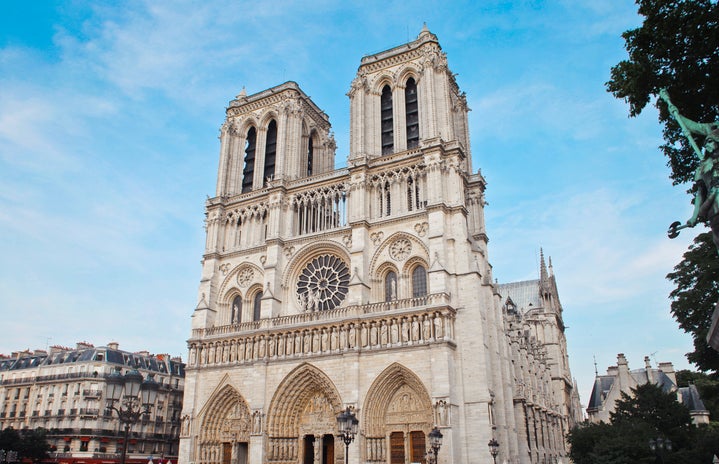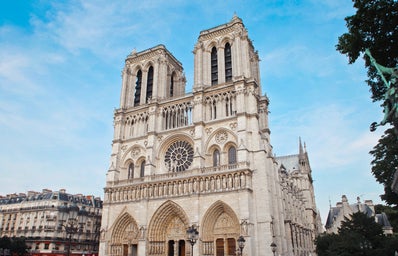Recently, I’ve been thinking back to a few summers ago. My family visited Notre-Dame de Paris. Standing far away, the structure alone is beautiful, but its detailed outside makes it even more wondrous. Its symmetrical portals are adorned with significant history: one depicts the life of the Virgin Mary, another portrays the resurrection, life, and judgment of Christ, and the third pictures the Virgin Mary holding Christ in her arms. Above these portals is a gallery of the several kings from the Old Testament. The outside of the cathedral resembles the Christian faith – it’s the gospel laid out, but the inside is what the masses of people wait outside for.
The inside of the cathedral is filled with beautiful stained-glass windows and mandalas of every color imaginable. The windows illustrate pivotal stories from the Bible. Some represent the Old Testament, but a majority focus on the Virgin and Christ. There are numerous sculptures, and even a whole panel dedicated to the entire New Testament. I wonder how a cathedral manages to compel and attract such a large audience. I ponder it often because I do not see that trend here.
When I visit home, I often walk past my old church, Covenant Restoration. With a 0.84 square mileage, my walking route doesn’t have the space to be too elaborate. An ugly building seated behind a peculiar looking sidewalk, it stands out. Its once red bricks are fading to a now-pale orange color, but the building somehow blends in a way that would make people driving past not even realize it was there. A town built on a hill cannot be hidden, yet this one hides. The big white doors are left open on Sunday mornings, almost as an invitation.
I think back to when I was six years old. I looked around on Sunday mornings, excited to see children my age. Over the years, we watched as the congregation grew smaller and smaller. So many people left until suddenly, 2019 came and it was just me, mom, dad, Ken, Jane, Paul, and Cindy. The church never addressed the loss of numbers, but one of the families that left warned us not to trust places that never grow.
I think often of the stained-glass windows I saw at Notre-Dame and wonder how long Covenant hid behind their own and whether I contributed to the masquerade. In the middle of 2018, a person at my church manifested demons. Her eyes would roll to the back of her head, she crawled around on all fours, and tried to throw a chair at my pastor’s wife. These behaviors appeared eerily similar to people who were “under the influence of the Holy Spirit”, which we have seen at Sunday night services or conferences we were encouraged to attend. Deeply disturbed by the parallels, we began researching and found podcasts that discussed these instances. Before researching, we had only ever heard the importance of our emotions, which seemed odd considering that faith is centered around a relationship with Christ.
At Covenant, people made scripture appear to say what they wanted it to say. They would make sermons or stories self-centered, citing one or two verses to fit their narrative. Once I realized this, I was able to identify my mistake: I trusted every word that came out of my pastor’s mouth simply because he was the head of the church. I wasn’t sure any longer if I believed in God, trusted him, or simply believed in the God that he spoke about.
The church had been turning to a different gospel – they weren’t concerned about the new creation at all. They were focused on the law – naming what we could do to warrant blessings – rather than being humbled by Jesus’ sacrifice. I wonder if standing before a congregation, before the cross, behind a podium, with a lapel mic, speakers on, and the pastoral title, made the pastor feel as if he could say whatever he felt.
The irony of its name didn’t strike me until recently. Knowing what happens indoors, I’m not sure what they think they’re restoring. The people? The building? The relationships with God? I don’t miss it. I don’t miss reading song lyrics from an overhead projector. I don’t miss congregational prayers that lasted 15 minutes too long. I don’t miss the stern look Cindy, the pastor’s wife, would give me when I left after the sermon and didn’t stay for chit-chat and Sunday school. I don’t miss church gossip, or creaky stairs, walls that seemed to suffocate me, Cindy interrupting Paul’s sermon every five minutes, Cindy insisting to use the microphone even though the seven members could hear everything clearly, the uneven wall panels, and the hardwood floor patterns that I stared at, wishing to be anywhere but there. And above all, I’m angry they don’t realize any of this.
Before the building was Covenant Restoration, it was a Methodist church that almost 200 people attended, my grandma included. One Sunday, a shaking Cindy (“under the power of the Holy Spirit”) approached the pastor. She called him out in front of the whole congregation for having an affair. The people were astonished at her daring move, but she said God had told her to do so. To this day, there are still whispers that she’s crazy. A few days later, the cross attached to the top of the building fell off and shattered all over the cement. Cindy saw this as a powerful sign from God that she had done the right thing, but I believe it was a warning of the brick and mortar of us, a forewarning that God has the final say – that God is the ultimate judge.
It was a cautionary reminder that we can give tithes, sacrifice everything, pray all day, fast for forty days and forty nights, but we still might be the white-washed sepulchers. We can pretend to walk by the Spirit on Sunday mornings but secretly gratify in fleshly desires during the week. Our lips can drip with honey, but we can still be filled with wormwood.
You can do all you want to a building. You can spend upwards of $80,000 to fix the brick and mortar. You can make it pretty. You can make it appealing to the public eye. You can build portals of Old Testament kings and illustrate the gospel on the outside. You can do all this and more, but that doesn’t guarantee that the inside reflects it. The inside might be ugly.
It’s painful to compare Covenant Restoration to Notre-Dame. People stare at one building in reverence, as both the inside and outside are direct manifestations of the very pillars that followers of Christ hold dear. But the other is a building people stare at in confusion, perhaps thinking, “Oh, I thought that church was closed down.” The inside is pitiful. The Notre-Dame is the gospel in pictures, statues, and engravings that remind us of the beauty of true faith. Covenant Restoration is a battered building that 150 people once attended regularly, and eventually dwindled to fewer than ten. The poor upkeep and watered-down gospel is a sad defeat and raises the question of what really needs restoration.

